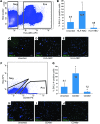Eliminating malignant contamination from therapeutic human spermatogonial stem cells
- PMID: 23549087
- PMCID: PMC3613920
- DOI: 10.1172/JCI65822
Eliminating malignant contamination from therapeutic human spermatogonial stem cells
Abstract
Spermatogonial stem cell (SSC) transplantation has been shown to restore fertility in several species and may have application for treating some cases of male infertility (e.g., secondary to gonadotoxic therapy for cancer). To ensure safety of this fertility preservation strategy, methods are needed to isolate and enrich SSCs from human testis cell suspensions and also remove malignant contamination. We used flow cytometry to characterize cell surface antigen expression on human testicular cells and leukemic cells (MOLT-4 and TF-1a). We demonstrated via FACS that EpCAM is expressed by human spermatogonia but not MOLT-4 cells. In contrast, HLA-ABC and CD49e marked >95% of MOLT-4 cells but were not expressed on human spermatogonia. A multiparameter sort of MOLT-4-contaminated human testicular cell suspensions was performed to isolate EpCAM+/HLA-ABC-/CD49e- (putative spermatogonia) and EpCAM-/HLA-ABC+/CD49e+ (putative MOLT-4) cell fractions. The EpCAM+/HLA-ABC-/CD49e- fraction was enriched for spermatogonial colonizing activity and did not form tumors following human-to-nude mouse xenotransplantation. The EpCAM-/HLA-ABC+/CD49e+ fraction produced tumors following xenotransplantation. This approach could be generalized with slight modification to also remove contaminating TF-1a leukemia cells. Thus, FACS provides a method to isolate and enrich human spermatogonia and remove malignant contamination by exploiting differences in cell surface antigen expression.
Figures






Similar articles
-
Fluorescence- and magnetic-activated cell sorting strategies to isolate and enrich human spermatogonial stem cells.Fertil Steril. 2014 Aug;102(2):566-580.e7. doi: 10.1016/j.fertnstert.2014.04.036. Epub 2014 Jun 2. Fertil Steril. 2014. PMID: 24890267 Free PMC article.
-
Separating spermatogonia from cancer cells in contaminated prepubertal primate testis cell suspensions.Hum Reprod. 2011 Dec;26(12):3222-31. doi: 10.1093/humrep/der343. Epub 2011 Oct 20. Hum Reprod. 2011. PMID: 22016413 Free PMC article.
-
Dynamic changes in EPCAM expression during spermatogonial stem cell differentiation in the mouse testis.PLoS One. 2011;6(8):e23663. doi: 10.1371/journal.pone.0023663. Epub 2011 Aug 15. PLoS One. 2011. PMID: 21858196 Free PMC article.
-
Spermatogonial stem cells, infertility and testicular cancer.J Cell Mol Med. 2011 Mar;15(3):468-83. doi: 10.1111/j.1582-4934.2010.01242.x. J Cell Mol Med. 2011. PMID: 21155977 Free PMC article. Review.
-
Is there a clinical future for spermatogonial stem cells?Curr Stem Cell Res Ther. 2007 Sep;2(3):189-95. doi: 10.2174/157488807781696258. Curr Stem Cell Res Ther. 2007. PMID: 18220902 Review.
Cited by
-
Cryopreservation of testicular tissue or testicular cell suspensions: a pivotal step in fertility preservation.Hum Reprod Update. 2016 Nov;22(6):744-761. doi: 10.1093/humupd/dmw029. Epub 2016 Aug 27. Hum Reprod Update. 2016. PMID: 27566839 Free PMC article. Review.
-
Transcriptional profiling of β-2M-SPα-6+THY1+ spermatogonial stem cells in human spermatogenesis.Stem Cell Reports. 2022 Apr 12;17(4):936-952. doi: 10.1016/j.stemcr.2022.02.017. Epub 2022 Mar 24. Stem Cell Reports. 2022. PMID: 35334216 Free PMC article.
-
Germline stem cells: toward the regeneration of spermatogenesis.Fertil Steril. 2014 Jan;101(1):3-13. doi: 10.1016/j.fertnstert.2013.10.052. Epub 2013 Dec 5. Fertil Steril. 2014. PMID: 24314923 Free PMC article. Review.
-
Human germ cell formation in xenotransplants of induced pluripotent stem cells carrying X chromosome aneuploidies.Sci Rep. 2014 Sep 22;4:6432. doi: 10.1038/srep06432. Sci Rep. 2014. PMID: 25242416 Free PMC article.
-
Selecting Infants With Cryptorchidism and High Risk of Infertility for Optional Adjuvant Hormonal Therapy and Cryopreservation of Germ Cells: Experience From a Pilot Study.Front Endocrinol (Lausanne). 2018 Jun 5;9:299. doi: 10.3389/fendo.2018.00299. eCollection 2018. Front Endocrinol (Lausanne). 2018. PMID: 29922233 Free PMC article.
References
-
- Ries LAG, et al. SEER Cancer Statistics Review, 1975–2004. Bethesda, Maryland, USA: National Cancer Institute; 2007.
-
- Howlader N, et al. SEER Cancer Statistic Review 1975–2008. Bethesda, Maryland, USA: National Cancer Institute; 2010.
Publication types
MeSH terms
Substances
Grants and funding
LinkOut - more resources
Full Text Sources
Other Literature Sources
Medical
Research Materials
Miscellaneous

